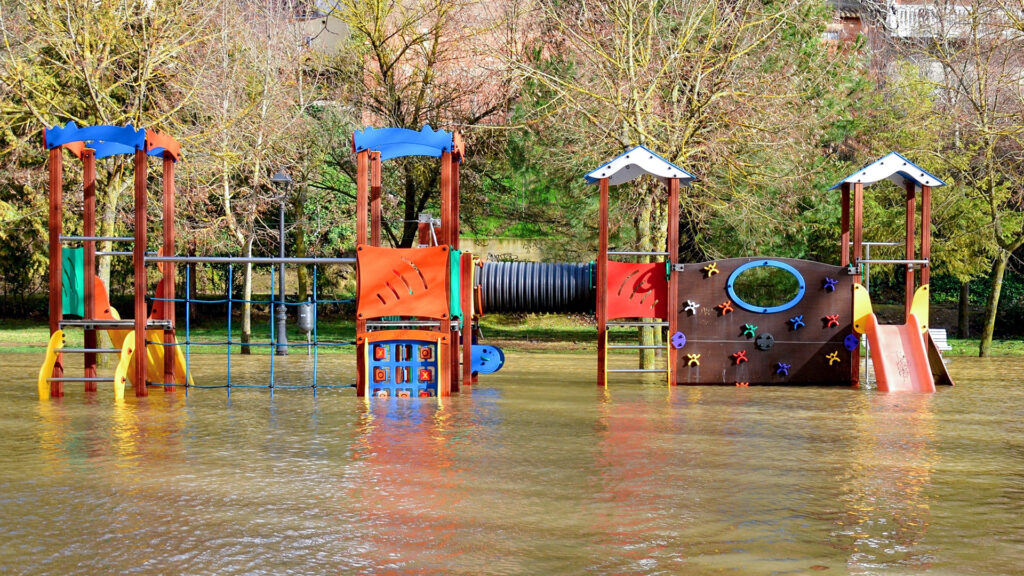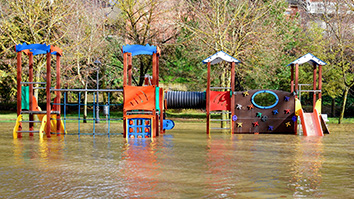
SRI examined how severe weather causes closures of early childhood education program sites while overburdening others, prompting a call to recognize the importance of these critical services and increase support.
In the aftermath of Hurricanes Helene and Milton, SRI researchers have released a first-of-its-kind study looking at the impacts of extreme weather on education-related services for young children.
The study assessed how severe storms and other major weather events affected enrollment and service delivery by Head Start and Early Head Start sites across the United States. Together, these critical programs are the largest federally funded education and well-being services for young children, offering comprehensive support in education, nutrition, and family assistance.
Overall, SRI found that about 40% of program sites were located in communities where at least one extreme weather event had struck in the past five years. Sites in these areas were more likely to be temporarily or permanently closed the following year than sites in non-affected areas, meaning even long after a disaster, some hard-hit communities remained cut off from valuable services.
The study further showed that Head Start sites that remained open in affected areas saw a significantly higher number of children over the following year — an average of around 17,000 more across all affected sites. While partly offsetting loss of access due to surrounding site closures, this annual jump sometimes exceeded sites’ service capacities. As a result, fewer children at overburdened sites received developmental screenings — a valuable benefit that allows for effective interventions and access to services.
Overall, the new study revealed the dramatic negative effect that severe weather has on child-focused healthcare service delivery — an impact likely to grow as extreme weather is projected to increase in decades to come.
“We were surprised by how many program sites experienced closures, as well as by the geographic extent — basically, nowhere in the country was safe from extreme weather,” said Todd Grindal, co-director of the Center for Learning & Development at SRI and lead author of the study. “This study documents a national problem of extreme weather disrupting critical infrastructure that supports kids and families.”
The SRI researchers describe their study as a “call to action” for recognizing the importance of child-centered services and treating them as vital social institutions.
“Our hope is that the Office of Head Start and other critical support programs, along with disaster preparedness organizations, will see these findings and recognize that early childhood services are incredibly important for the short- and long-term development of kids and families,” said Grindal. “These programs need to have the same level of priority as hospitals, police departments, and emergency services.”
Widespread disruption
Grindal, a lecturer at Harvard, whose background is in teaching and evaluating programs, became inspired to pursue the research based on the experience of his sister, who worked as a Head Start administrator in the Florida panhandle. When Hurricane Michael swept through in October 2018, a big tree toppled right on top of her Head Start center. Nobody was injured, but the storm-related damage shuttered services for local families for months because policymakers did not prioritize reopening the site.
“These programs need to have the same level of priority as hospitals, police departments, and emergency services.” — Todd Grindal
To examine the extent to which these kinds of disruption were occurring on a national level, Grindal — along with SRI colleagues Paul Burkander and Nicholas Ortiz — gathered data from Head Start, Federal Emergency Management Agency (FEMA), and community demographics from the American Community Survey (ACS). From 2012 to 2017, the researchers saw that more than 8,000 Early Head Start and Head Start sites — nearly half the national total — were located in communities that experienced events including wildfires, storms, tornadoes, or floods extreme enough to merit a federal presidential disaster declaration.
Researchers estimated that more than half a million children were served by affected areas. Within 45 days of Head Start enrollment, children are supposed to receive developmental screenings to gain access to essential services. The overburdened sites weren’t able to provide necessary screenings, resulting in approximately 10,000 children (2.7 percent) who weren’t able to be screened. “We saw across Head Start program sites that as post-disaster enrollment went up, services went down,” says Grindal.
Informing disaster relief policy
While their study examined Head Start and Early Head Start programs, Grindal and colleagues expect that their findings revealing extreme weather repercussions on services are applicable to “child-focused services across the country and likely across the world,” said Grindal.
With extreme weather projected to surge in frequency and severity, the researchers advocate for greater emphasis on ensuring children and their families regain access to the same vital services that had been available to them before a disaster — which are needed even more after disasters abate.
“Taking care of kids is critical and it’s who we are as a people,” said Grindal. “Our country puts kids at the center in many ways, and these kids should be part of our disaster relief policy as we address extreme weather.” Additional research to create disaster response plans and tailor robust policies to bolster child-focused programs.
“We’re hopeful that this work will help districts understand how extreme weather disasters affect families so that we can prioritize young kids,” Grindal continued. “It’s not just about getting the schools and businesses back open — it’s about standing up for the kids who need these critical health and well-being programs.”
To get a copy of the report or to learn more about what SRI’s Education team can do for your community, please contact us.



